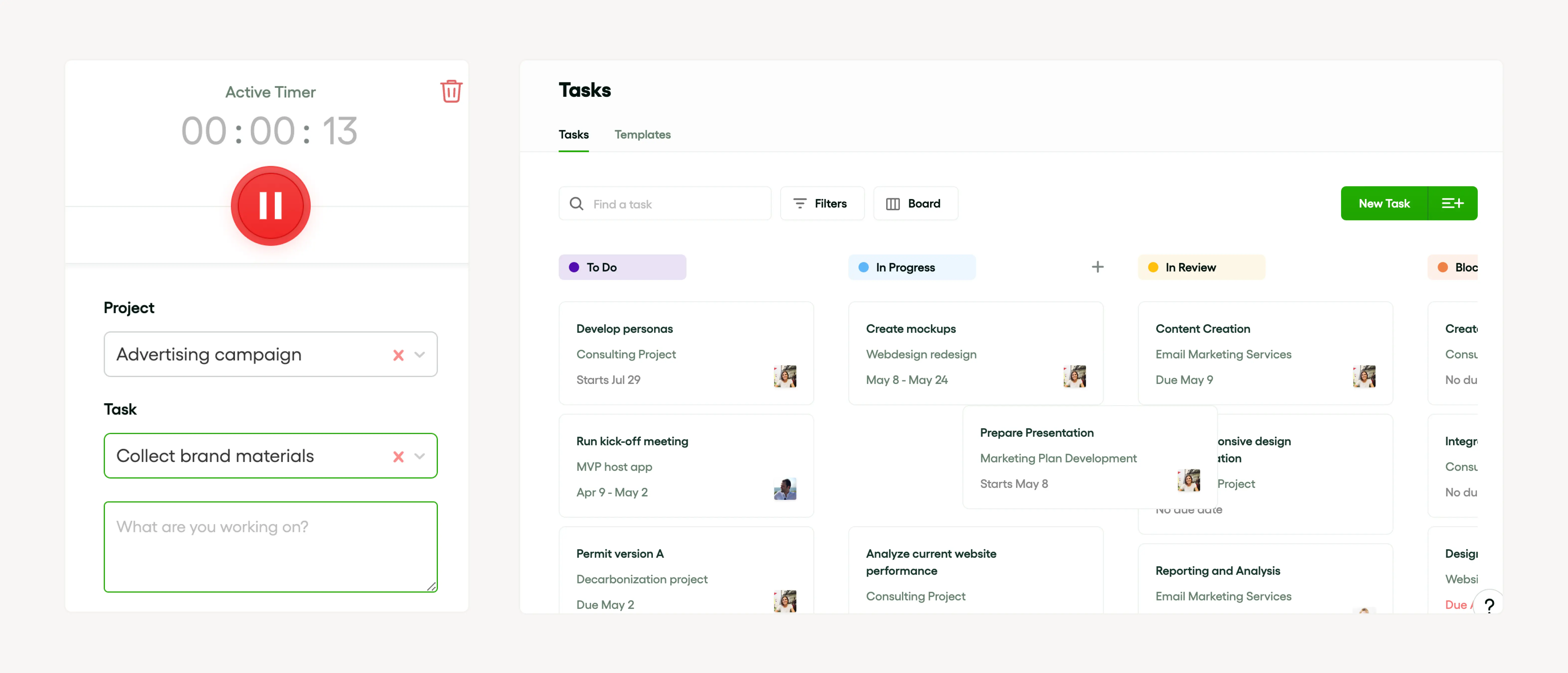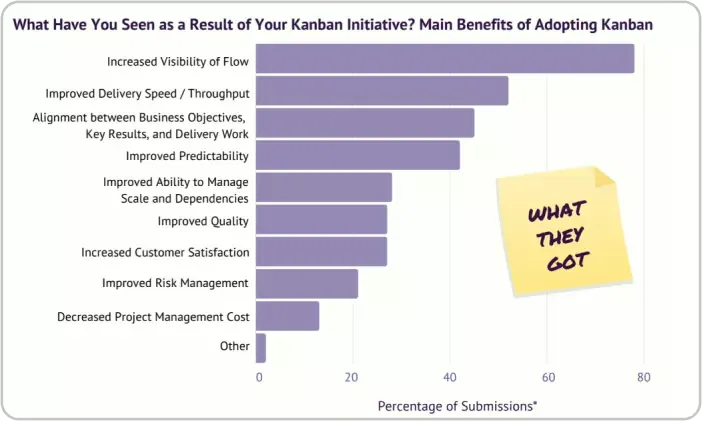Ever heard of Kanban? It's not just another buzzword—it’s a game-changer for project management.
Picture this: a Kanban board that lays it all out in front of you, from task assignments to what’s in the pipeline, boosting your task completion rates like nobody’s business. It’s a hot ticket in software development, perfect for keeping that backlog tidy and manageable.
Spotting a snag in your workflow? Kanban makes it a breeze to pinpoint and sort out, keeping the gears turning smoothly. With a streamlined Kanban flow, you’re looking at non-stop upgrades in how you handle tasks.
Plus, throw an Agile workload board into the mix, and you’ve got yourself a fine-tuned machine optimizing your work-in-progress like a pro.
Understanding the basics of Kanban flow
So, what’s the big deal with Kanban? At its core, it’s about seeing your workflow in living color, managing tasks, and keeping the improvement train rolling. The star of the show is the Kanban board—an Agile powerhouse that keeps everything transparent, from who’s doing what to how the backlog shaping up.
In the world of Kanban, we play it smart with work-in-progress limits, ensuring no stage gets too clogged up and everything moves along at a brisk pace. This isn’t just for the tech wizards; it’s a hit across various sectors because, let’s face it, who doesn’t want a workflow that’s slick and steadily getting slicker?
What is Kanban flow?
Kanban Flow isn’t just a tool; it’s your best buddy in project management. Anchored by the Kanban methodology, it’s all about keeping your workflow visible and under control. The Kanban board is where the magic happens—tasks are laid out, progress is tracked, and bottlenecks get the boot.
One of its ace features? Work In Progress (WIP) limits. These are your best defense against team overload, balancing the load so your team can tackle tasks without breaking a sweat. It’s about keeping the workflow fluid and efficient, especially in software development.
The origin and evolution of Kanban flow
This whole Kanban craze? It started in the hustle and bustle of Japan’s automotive scene at Toyota. Their goal? To amp up manufacturing efficiency. Kanban, or "billboard" if you're translating, then zoomed into software development, where it's all about visualizing tasks, managing the workload, and keeping a cap on WIP to dodge bottlenecks.
The Kanban board is basically a dashboard showing your process flow, making task assignment and backlog management a walk in the park. And those WIP limits? They’re your go-to for ensuring tasks glide smoothly from start to finish, all while nurturing a culture of getting better and better.
Key principles of Kanban flow
Let’s break down the Kanban playbook. First up, visualize your work. The Kanban board does just that, painting a clear picture of tasks and progress, making it a cornerstone of software development and beyond.
Next, we’re talking about WIP limits. By keeping a lid on how much is going on at once, you’re sidestepping potential logjams and smoothing out the task completion journey.
And lastly, it’s all about continuous improvement. With an Agile workload board that’s always evolving, you’re set to reflect, adapt, and enhance, driving efficiency and productivity through the roof. This isn’t just about keeping up; it’s about staying ahead.
The importance of Bonsai in project management
It's important to note, Bonsai is known for having the most comprehensive set of features in a project management tool. It's Kanban boards offer a clear advantage: a visual workflow that simplifies task management from start to finish. Bonsai's Kanban flow integrates seamlessly with time tracking and resource allocation features, providing a comprehensive overview of project health. Managers can monitor the flow of tasks and redistribute resources as needed to address any emerging issues promptly.
Bonsai's task management capabilities allow for efficient tracking and management of tasks, ensuring that team members understand their roles and responsibilities within the project reports
Here's how to use them for maximum efficiency:
Kanban boards
Visualize your workflow with Kanban boards. Move tasks between stages (e.g., To Do, In Progress, Done) for a clear understanding of progress. It allows teams to limit work in progress, which is essential for maintaining focus and reducing multitasking that can lead to errors and delays.
By displaying tasks in a clear, card-based format, team members can easily prioritize work and update their status with drag-and-drop simplicity. This immediate visual feedback loop enables quick adjustments and fosters a culture of agility and continuous improvement.

Integrated timers
Start timers directly from tasks to track time spent. Bonsai's integrated timers enhance project management by allowing you to start new timers directly from your task list, ensuring accurate time tracking. This feature also enables the assignment of new tasks to the hours you've already billed, streamlining the billing process and improving project time management efficiency.
Users can record time with an in-app timer, log hours on timesheets, and monitor hours to optimize billable time. This detail is key for effective budgeting, preventing cost overruns and missed deadlines.

Team collaboration
Assign tasks to team members. Invite collaborators to your projects to assign tasks and add comments for each other. Bonsai fosters team collaboration by providing a shared workspace where members can easily communicate, manage tasks, and track progress. Its integrated tools promote transparency and collective effort, ensuring that every team member is aligned with the project's objectives and can contribute effectively to the project's success.

Benefits of implementing Kanban flow in project management

Using Kanban flow in project management is like having a magic wand for task management. It helps you prioritize tasks and visualize the workflow with a Kanban board, making it easy to spot bottlenecks. This boosts backlog management, letting teams zero in on work-in-progress tasks and speed up completion.
Kanban also sets Work In Progress (WIP) limits, which is crucial to avoid overloading and keep things running smoothly. In software development, for example, an Agile workload board simplifies task assignment and execution. So, Kanban flow is a powerhouse for efficiency and productivity.
Enhanced visibility and transparency
A Kanban board is a game-changer in project management, especially in software development. It ramps up visibility and transparency, helping you spot workflow bottlenecks, assign tasks, and manage backlogs. The Kanban method focuses on task management and WIP limits, driving efficiency.
An Agile workload board gives a clear view of the workflow, helping teams track task completion and ongoing work. WIP limits prevent team members from getting swamped, ensuring continuous improvement. These tools lead to a more efficient and transparent operation, boosting productivity and teamwork.
Improved workflow efficiency
To boost workflow efficiency in software development, tools like the Kanban board are essential. This visual board helps with task management, assignment, and backlog management, providing a real-time view of work-in-progress and enhancing project management.
Using the Kanban method helps identify workflow bottlenecks for continuous improvement. WIP limits control the amount of work at any stage, preventing overload and ensuring quick task completion. This keeps the team balanced and productive.
Reduced wastes and bottlenecks
Kanban methodology in project management slashes workflow bottlenecks and waste. A Kanban board visualizes the workflow, aids in backlog management, and sets WIP limits. The goal is to streamline task completion and foster continuous improvement.
WIP limits are key to cutting waste, ensuring teams don’t get bogged down with too many tasks. An Agile workload board further enhances this by managing tasks and pinpointing which ones need immediate attention to avoid delays.
How to implement Kanban flow in your agency
Thinking about bringing Kanban into your agency’s flow? Smart move!
- Start by setting up a Kanban board. This isn't just any board; it's your roadmap to visualizing workflows, assigning tasks, and spotting any clogs in the system—all in real time. This bird’s eye view is perfect for keeping projects on track and making sure your team isn’t biting off more than they can chew.
- You’ll want to set up Work In Progress (WIP) limits next. These are your best bet for keeping your team’s workload manageable and making sure that tasks flow smoothly from start to finish without piling up. They’re like speed bumps—there to keep things from moving too fast and getting messy.
- And don’t forget about rolling out an Agile workload board. This lean, mean organizing machine is all about flexibility and efficiency, adapting on the fly to fit your team’s needs as you shift into Kanban gear.
Steps to set up a Kanban board
Ready to get your Kanban board off the ground? First off, chart out your workflow stages—think backlog, in-progress, and completion. Lay these out on your board, setting clear WIP limits for each to dodge any bottlenecks that could slow down your team.
Populate the board with tasks, sliding them from left to right as they make their way through the Kanban flow. This visual progression isn’t just satisfying; it’s a powerful way to push continuous improvement and keep your project management on point, especially in software development.
Defining work-in-progress limits
WIP limits are the backbone of Kanban, helping you keep a tight rein on how many tasks are in the works at any given stage. Pinning down the right number is key—it’s what keeps your team’s work tempo steady without overwhelming them, boosting overall efficiency in the process.
On an Agile workload board, these limits should be tailored to what your team can realistically handle, ensuring smooth task turnover and a workflow that’s both clear and constantly evolving.
Managing and improving the flow
Using Kanban in project management, especially in software development, is all about refining task management and pinpointing any hiccups in your workflow. A well-set Kanban board lights up your work process, underlining any WIP limits and paving the way for ongoing enhancements.
An Agile workload board amps up this setup by focusing on work-in-progress, which can be tweaked as needed, smoothing out your project management and cementing continuous improvement.
Real-life examples of Kanban flow in action

In software projects, Kanban steps up as a visual task manager. Tasks on the Kanban board paint a clear picture of what’s underway and what’s wrapped up, helping manage the flow and fine-tune the backlog strategy.
In broader project management, Kanban sharpens task assignment. WIP limits keep tasks from piling up, promoting a balanced workload on your Agile board and enabling real-time tweaks that drive continuous improvement.
How Spotify uses Kanban flow
Spotify tunes into Kanban for its software development, using a Kanban board to keep its workflow in harmony. Each task is mapped out on the board, showing what’s in progress and spotlighting any slowdowns. This setup not only streamlines task management but also ensures that adjustments and backlog handling are spot-on, fostering constant growth and quality in their outputs.
They’re strict about their WIP limits, keeping team loads in check and ensuring that every task can hit its deadline without sacrificing quality.
Application of Kanban flow in Zara’s supply chain
Zara stitches Kanban into its supply chain management to keep things running smoothly from design through to distribution. Their approach features a visual workflow on a Kanban board, managing everything from design tasks to production steps. This method helps them proactively tackle any bottlenecks, manage backlogs effectively, and keep their operations continuously improving.
Top Kanban flow tools for agencies
When it comes to boosting project management in agencies, there are loads of Kanban Flow tools that are the bee’s knees. These tools are great for assigning tasks, tracking progress, and managing backlogs. They use the Kanban method, which is also handy for occasional software development.
Key features often include a visual workflow on a Kanban board, work-in-progress (WIP) limits for steady output, and an Agile workload board for overall task management. These tools are crucial for spotting and fixing workflow bottlenecks, promoting continuous improvement.
Benefits and advantages of Bonsai
Bonsai’s Kanban Flow Tools give a dynamic, visual way to manage workflows and projects. These tools are designed to boost efficiency, transparency, and teamwork, which are vital in a fast-paced project setting. It simplifies project management by centralizing tasks, files, and communication. It streamlines collaboration, boosts team efficiency, and keeps everyone focused on achieving project goals. This translates to projects delivered on time and within budget.
- Bonsai’s Kanban boards offer a clear visual of all tasks, letting teams see the status of work at a glance.
- By visualizing tasks, teams can quickly spot bottlenecks and inefficiencies, leading to smoother processes.
- The Kanban board fosters a collaborative environment where team members can easily update task statuses and share info.
- Bonsai’s Kanban tools are flexible, adapting to changing priorities so agencies can respond quickly to client needs.
- The Kanban method encourages ongoing workflow refinement, helping agencies evolve their processes over time.

In short, Bonsai’s Kanban Flow Tools are a game-changer for agencies looking to optimize project management and boost team productivity. They provide real-time insights into project progress and facilitate effective communication, making them a valuable asset for any agency aiming for top-notch work efficiency.
Overview of Trello
Trello is a popular project management tool that uses the Kanban method, offering a visual workflow for task management. It’s great for various tasks, including software development, backlog management, task assignment, and monitoring WIP limits.
With its Agile workload board, users can efficiently handle their work, spot workflow bottlenecks, and promote continuous improvement.
Using a Kanban board, Trello allows for transparent task tracking, promoting organization and efficiency. It shows the current status of tasks, providing an essential tool for understanding work-in-progress at any time.
Features and benefits of Asana
Asana is a top project management tool with a ton of features to streamline workflows and boost team productivity. Its Agile workload board offers a visual workflow, aiding in task management and assignment. For software development projects, the Kanban method is used through its Kanban board, easing backlog management and promoting continuous improvement.
Asana helps identify workflow bottlenecks and maintain WIP limits, promoting efficient task completion. With its capabilities for monitoring work-in-progress and managing backlogs, Asana helps users tackle issues related to project execution and delivery, making it a go-to tool for teams across various industries.
Why choose Jira for Kanban flow?
Choosing Jira for Kanban flow brings numerous benefits for project management, software development, and task assignment. The Kanban board visualizes workflow, helping to monitor WIP limits and spot workflow bottlenecks. This promotes continuous improvement by ensuring smooth task completion.
Key features include backlog management on their Agile workload board, giving team members a clear view of their tasks using the Kanban method. Task management is simplified, aiding in project progress tracking and boosting productivity.
Common challenges and solutions in Kanban flow implementation
Jumping into Kanban can sometimes feel like paddling upstream, especially when you hit common snags like workflow bottlenecks, setting just-right Work In Progress (WIP) limits, and managing a messy backlog. These issues can clog up your flow, slowing down tasks, and tossing task assignments out of whack. If your backlog management is off, it can throw a wrench in the whole project, particularly in software development.
The trick to dodging these troubles? Get your Kanban board dialed in. This visual champ helps you track where projects are at and spot any clogs in real-time. Plus, keeping a keen eye on continuous improvement can shift your task management from surviving to thriving.
Dealing with overburdening and multitasking
In the world of project management, juggling too much or flipping between tasks can tank your team’s efficiency. Slap a Kanban board up there, and you’ll get a clear picture of everyone’s load, helping to smooth out task assignments and clear up any logjams.
Kanban’s WIP limits are your best friend here. They keep your team focused by limiting how much can be in the works at once, nixing the chaos of multitasking. This approach not only makes managing tasks easier but also amps up your project’s finish rate.
Addressing resistance to change
Change isn’t always welcomed with open arms, especially in the structured world of project management and software development. To ease this tension, show how tasks flow with a Kanban board—everyone can see what’s up with assignments, backlogs, and WIP limits live and in color.
Setting firm WIP limits also cuts down on the overwhelm of multitasking, letting your team finish what they start before diving into something new. Stick to Kanban’s principles, and you'll smooth out many of the bumps that come with shifting workflows.
Ensuring continuous improvement
To keep leveling up in project management, especially in software development, you’ve got to nail tasks and backlog management. Using Kanban gives you a leg up by keeping your workflow visible on the board—there’s no guessing who’s doing what or how close things are to completion.
Don’t forget about those WIP limits. They’re crucial for making sure your team isn’t biting off more than they can chew, keeping your workflow smooth and manageable. The Agile workload board isn’t just a tool; it’s your roadmap to continuous improvement, providing a snapshot of ongoing progress and areas ripe for a tweak or two.
Conclusion: Maximizing efficiency with Kanban flow
Wrapping it all up, Kanban isn’t just another method; it’s a powerhouse for cranking up efficiency with its clear visual workflow on the Kanban board. It tackles task assignment and completion head-on, ensuring nothing gums up the works and keeps the improvement train rolling.
With solid backlog management and WIP limits in place, your Agile workload board becomes the control center for managing tasks effectively, ensuring no task oversteps its bounds and productivity stays peaked.
Using Kanban right can seriously rev up your project management game, transforming potential chaos into a streamlined symphony of productivity.







